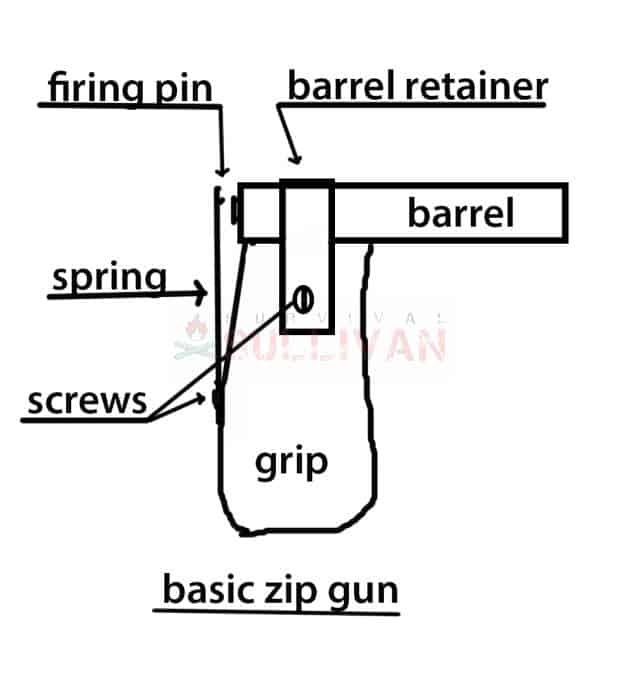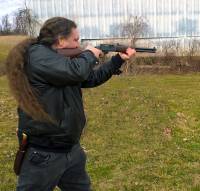In WWII the United States created a cheaply made, single-shot, .45 ACP handgun called the Liberator. At a cost of about $2 per gun, one million of them were manufactured by the headlight division of General Motors in just under three months.
The guns were quickly and cheaply made, the barrels weren’t even rifled. They came with 10 rounds of .45 ACP cartridges, and a wooden dowel rod that came with it was the “ejector”.
The grip was made to stow a few extra rounds. They were intended to be picked up by resistance fighters, and used to kill an occupying enemy soldier and relieve him of his gear and weapons. They were intended to be used at very close range, up to about five yards. The users best bet would have been to put it right against their targets head or chest.
Of the one million made, only a few thousand were actually ever dropped. No one knows how many were ever actually used, although there is a historical picture of a French resistance fighter with one stuck in the front of his pants.
Table of Contents
The Zip Gun
The idea behind the Liberator was based in its name. It was intended to liberate an occupied people. In essence, the Liberator was nothing more than a zip gun. A zip gun is a cheaply, quickly made gun, usually a single use.
Often the zip gun was as dangerous for the shooter as it was for anyone the shooter may be pointing it at. Making a zip gun should be reserved for instances of SHTF and TEOTWAWKI.

Most often the zip gun is made in a smaller caliber like .22 LR. This is because cheap, readily available materials, like fuel lines and brake lines, are used as the barrel. Conveniently, fuel lines and brake lines are about the right diameter for that caliber too.
Bigger Isn’t Always Better
In a previous article, I wrote about making a single-shot shotgun I call a slider shotgun. Those actually originated in the Philippines during WWII when the citizens tried to fight off invading Japanese armies.
The Filipinos called it a paliuntod; now there are videos all over YouTube, and they are called all different names. In that article I also mentioned having made a 20 gauge, single shot, zip gun shotgun when I was a kid.
That size of a zip gun isn’t as practical for stealth as the pistol size because most often a zip gun was made by a “bad guy” to do bad things with. Because of that, they needed a smaller, more easily concealed gun. Small caliber cartridges for a zip gun are just advisable for your own safety as well. The idea behind making a zip gun here is to defend yourself and your loved ones in cases of SHTF and TEOTWAWKI.
Pistol cartridges like a 9mm have very high chamber pressures and so trying to use that in a zip gun would likely cause you to lose some fingers, if not your whole hand. If I were going to make a zip gun for myself I would say that a .32 ACP would be about the largest caliber I would use. Maybe a .380, but I’d have to make sure I had some thick, tough steel for the barrel.
The .32 ACP doesn’t have a very high chamber pressure and with a quality hollow point projectile it can expand to a diameter on the order of about 0.4 – 0.45 inches. That’s a pretty good-sized hole. Most often people will use the .22 LR to make a zip gun. If for no other reason, it is because of that readily available tubing diameter factor.
Steps to Making a Zip Gun
Before we discuss making a zip gun I would like to point out that, in my state, it is legal for me to make firearms for MY PERSONAL USE. I can’t sell them or cross state lines with them, and handguns MUST have a rifled barrel. All federal laws must be observed. Most zip guns do not have rifled barrels.
If you find a short length of tubing that is strong enough to withstand the pressure you are halfway there. Brake line tubing is often used because it has an acceptable inside diameter, and it is a hydraulic pressure line, so it can withstand the pressure of a .22 cartridge.
The simplest form of zip gun is a barrel mounted onto a grip with a strip of springy metal screwed to the back of the grip. The springy metal strip is drilled, and a screw is positioned so that it hits the rim of the .22 cartridge. File the screw point flat so it hits solid on the rim of the cartridge.
Parts list for a simple .22 LR zip gun:
- Grip
- Metal tube for barrel (usually an automobile brake line will suffice)
- Metal strip (springy if possible)
- Rubber bands (if metal strip is not springy)
- Three screws
If you decided to make a larger caliber, then position the screw to hit the primer of a centerfire cartridge. You still need to file the point off of the screw. If you don’t have springy metal, then just use a strip of any thin metal and simply wrap some rubber bands around the grip and metal strip so that the strip acts as a spring.
Keep in mind that if you can’t get .22 LR ammo you can always go to the hardware store and buy .22 caliber blank cartridges for nail guns, then go to Waldens world o’ Chinese-made stuff and buy a box of .22 caliber pellets. Load a pellet, put the blank behind it, pull the trigger and it goes bang.
And actually, that method is a little more powerful than a standard .22 LR if you use the hotter blanks, believe it or not. You can buy various power blanks so if you get the most powerful blank it will send that pellet fast, but even the weaker ones will still take small game like squirrels and rabbits.
This video really gives you good information on the velocities you get firing pellets with blanks:
Better than a zip
If you want to make a handgun that is a little better than just a zip gun, there are a few ways to go about it. You can build it from scratch and take a lot of time and make a real, actual gun if you have the skills and tools. But most of us don’t have either of those to do that.
But you can get closer to a real gun by using an actual trigger and hammer or striker to fire the round, rather than just using a strip of metal and rubber bands. It just depends on how much time you have and what you want to do with it.
You can take a .22 caliber pellet rifle and convert it to fire live .22 LR ammo fairly easily. In the United States that would be legal to do, in your country if you aren’t supposed to have guns then you shouldn’t do that. I read that in some countries you have to have a special license even to own a pellet rifle!
Last Shot
What it comes down to is that if you are living under the laws of your state or country, you have to follow those laws. But if a time comes when there are no longer governments and laws then you must do what you have to do to protect your family from bad people and to hunt to provide food. This may entail building a homemade gun.
Of all the options there are, if you need a firearm for protection or hunting quickly, then making a zip gun might be the answer. It will give you the immediate means of protection and allow you more time to make something better or to use it to obtain better equipment, including genuine firearms.
I am not advocating breaking any laws, but I do feel strongly about protecting myself and my loved ones, especially if a time of lawlessness were to arise. Firearms are such an essential part of life here in the United States that our constitution guarantees us the right to keep and bear arms.
Most Americans already own at least one, if not several firearms so we don’t have to worry too much about having to make one for protection. But it’s always good to know how, just in case.

Eric Eichenberger is an avid outdoorsman, skilled marksman, and former certified range officer and instructor with nearly 40 years experience handling and repairing firearms.
A skilled craftsman with a strong love for working with his hands, Eric spent 20 years as a carpenter and custom woodworker in high end homes. As a gold and silversmith he has created hundreds of pieces of jewelry over the years using the lost wax casting method.
The grandson of humble country folk, he was raised with the “do it yourself” mentality and so is accustomed to coming up with unique solutions to problems utilizing materials at hand.
